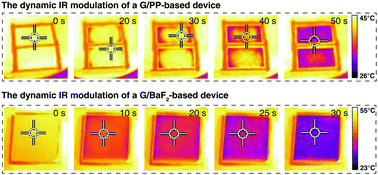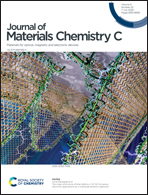Graphene-based reversible metal electrodeposition for dynamic infrared modulation†
Abstract
Dynamic modulation of thermal radiation has emerged as an important field of research in recent years, and it has shown a wide range of potential applications in energy-efficient buildings, personal thermal management, adaptive camouflage and spacecraft thermoregulation. Herein, inspired by the unique optical properties of metals and the excellent optical and electrical properties of graphene, we develop dynamic infrared (IR)-modulation devices by reversibly electrodepositing metals on graphene-based electrodes. The as-prepared graphene-based electrodes show high IR transparency and acceptable sheet resistance on the O2 plasma-treated polypropylene (PP) films and the zinc oxide (ZnO)-modified barium fluoride (BaF2) substrates, satisfying the basic requirements of achieving dynamic IR modulation in reversible metal electrodeposition (RME) systems. Moreover, by assembling the two types of graphene-based IR-transparent electrodes into a two-electrode RME system and after electrodepositing for tens of seconds, both of the two devices exhibit substantial apparent temperature declines, indicating their potential IR modulation capabilities. Finally, we believe that incorporating IR-transparent graphene-based electrodes into RME systems may provide a possible dynamic IR-modulation approach for inspiring and bettering many thermal radiation management-related technologies.



 Please wait while we load your content...
Please wait while we load your content...